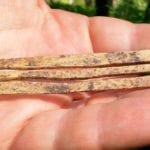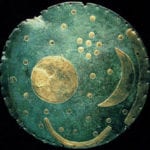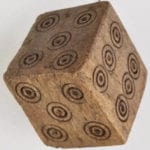 Weird Stuff
Weird Stuff  Weird Stuff
Weird Stuff  Our World
Our World 10 Ways Your Christmas Tree Is More Lit Than You Think
 Movies and TV
Movies and TV The 10 Coolest Stars to Set Sail on The Love Boat
 History
History 10 Things You Didn’t Know About the American National Anthem
 Technology
Technology Top 10 Everyday Tech Buzzwords That Hide a Darker Past
 Humans
Humans 10 Everyday Human Behaviors That Are Actually Survival Instincts
 Animals
Animals 10 Animals That Humiliated and Harmed Historical Leaders
 History
History 10 Most Influential Protests in Modern History
 Creepy
Creepy 10 More Representations of Death from Myth, Legend, and Folktale
 Technology
Technology 10 Scientific Breakthroughs of 2025 That’ll Change Everything
 Weird Stuff
Weird Stuff Ten Bizarre Facts About The Doge Meme
 Our World
Our World 10 Ways Your Christmas Tree Is More Lit Than You Think
 Movies and TV
Movies and TV The 10 Coolest Stars to Set Sail on The Love Boat
Who's Behind Listverse?

Jamie Frater
Head Editor
Jamie founded Listverse due to an insatiable desire to share fascinating, obscure, and bizarre facts. He has been a guest speaker on numerous national radio and television stations and is a five time published author.
More About Us History
History 10 Things You Didn’t Know About the American National Anthem
 Technology
Technology Top 10 Everyday Tech Buzzwords That Hide a Darker Past
 Humans
Humans 10 Everyday Human Behaviors That Are Actually Survival Instincts
 Animals
Animals 10 Animals That Humiliated and Harmed Historical Leaders
 History
History 10 Most Influential Protests in Modern History
 Creepy
Creepy 10 More Representations of Death from Myth, Legend, and Folktale
 Technology
Technology 10 Scientific Breakthroughs of 2025 That’ll Change Everything
10 Enigmatic Gold Artifacts
Mankind craves gold. Its rarity makes it extremely valuable, and its everlasting luster symbolizes the Sun’s power and immortality. The archaeological record is filled golden objects that have remained shining through the centuries. Given the value of this precious metal, these artifacts are almost always more than just art; they’re statements of power, faith, or cultural identity. Many remain a mystery to modern scholars.
10 Golden Curse Tablets
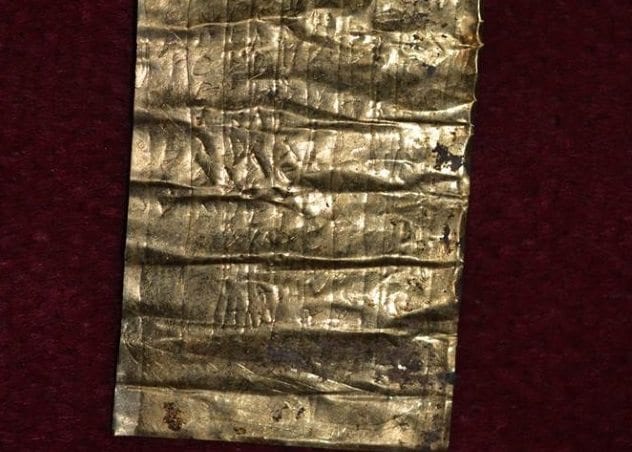
Curse tablets, or tabella defixionis, were common in ancient Rome. These inscriptions on metal were harnessed to bring vengeance. In August 2016, archaeologists discovered golden curse tablets in eastern Serbia. While some are written in Greek, others are written in an unknown language with indecipherable symbols. Some of the tablets are demonic invocations. Experts believe the unique symbols were a secret code between the user and the demon.
Dated to the fourth century AD, these tablets reflect a Roman Empire in flux. They reference Christian and pagan deities, revealing a slow transition in belief. Lead curse tablets have been discovered before, but these golden versions are unique. There was an ancient Roman prohibition against burying gold with the dead.
9 Great Golden Bell Of Dhammazei

The resting place of the Bell of Dhammazei remains one of Myanmar’s most enduring mysteries. Cast in the 15th century, the bell was composed of an alloy of gold, silver, and copper and weighed 300 tons. It once stood next to the Shwedagon Pagoda. In 1608, a Portuguese mercenary named Felipe de Brito seized the bell and dragged it to the Bago River. While he was attempting to ferry his prize across, the bell sank.
Its location remains a mystery. International teams with the latest in technology have been unable to find its resting place. The murky waters do not make the search easy. The Bago River has also changed course over the past 400 years, so it’s unlikely the search parties are in the right area. Others aren’t even sure the bell exists. Three central historical texts written 200 years after its construction fail to mention the mysterious music maker.
8 Gold Spirals Of The Sun Worshipers

In 2015, 2,000 gold spirals were unearthed in Zealand, Denmark. Dating between 900 and 700 BC, they measure roughly 3 centimeters (1.2 in) and are composed of pure gold thread. Archaeologists believe they were part of ceremonial clothing worn by the region’s Bronze Age Sun worshipers. They may have been embroidered on ritual garb, woven into hair, or worn in a headdress. Sun worship was one of the principal forms of Bronze Age spirituality. Given its brilliance and eternal luster, gold was magically linked with the Sun.
The site has one of the highest concentrations of gold in Northern Europe. Several golden broaches were found during the same dig. Before that, four gold bracelets were unearthed. In the 19th century, local farmers dug up six golden bowls in a nearby field. Experts theorize that this concentration of precious metal suggests that the area was particularly important to Bronze Age inhabitants.
7 Golden Rhino Of Mapungubwe
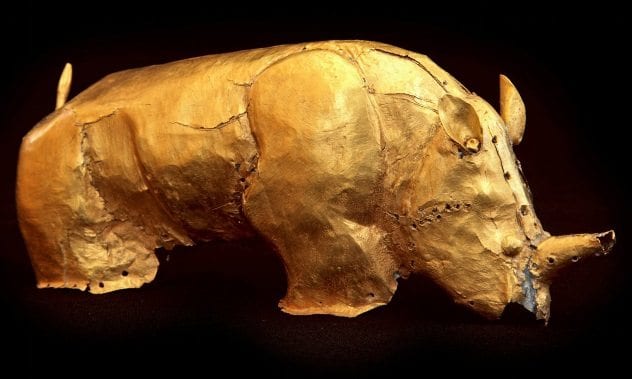
The Golden Rhino of Mapungubwe is one of the most important artifacts discovered in South Africa. It is composed of thin sheets of gold foil hammered over a delicately carved wooden frame. Along with the rhino, 9 kilograms (20 lb) of golden jewelry, beads, and other animal figures have been recovered.
Mapungubwe was the biggest kingdom in 13th-century sub-Saharan Africa. It was located along the Botswana border in South Africa. This sophisticated state had vast trade routes that stretched to Egypt and Asia.
For decades, the golden rhino was charged with political importance. When the figurine was unearthed in 1932, white South Africans refused to admit that black Africans had created the rhino. Its craftsmanship was a threat to the apartheid ideology that provided the basis of the state. Now, experts agree that the Rhino of Mapungubwe was made locally in the precolonial period.
6 Gold Rings Of The Griffin Warrior
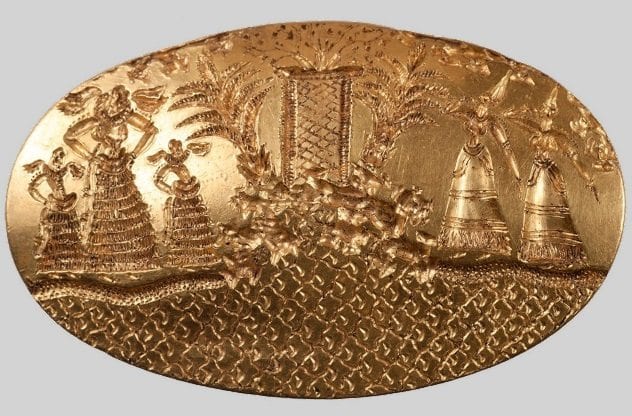
In 2015, archaeologists unearthed the grave of a warrior in Southwestern Greece. Dated to 1500 BC, the tomb contained a 30-year-old man dubbed the “Griffin Warrior.” The grave was filled with immaculate artifacts, including four mysterious golden rings. The rings are composed of several sheets of gold and contain intricate imagery from Minoan mythology. Experts believe these rings were crafted in Crete and used as seals for official documents.
The Minoan civilization of Crete disappeared mysteriously in 1200 BC. The prevailing theory has been that Mycenaean Greeks conquered the Minoans and absorbed their culture. However, some suggest that the rings reflect cultural interaction and an exchange of ideas. Minoan objects may even have held special reverence as symbols of political power, as Minoan culture was penetrating the mainland at this time. Their aesthetic and building styles had already influenced the Mycenaeans. Others believe the rings are plunder.
5 Undiluted Scythian Style
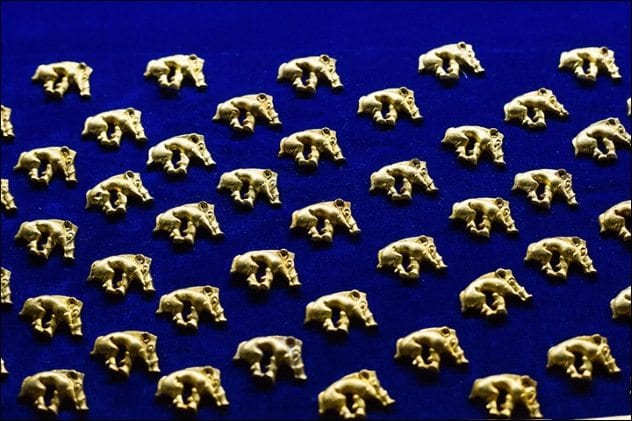
In 1998, archaeologists unearthed a mysterious cache of gold near Kyzyl, the capital of Tuva in Southern Siberia. In the tomb of a sixth-century BC man and woman, they discovered 5,000 gold pieces, weighing 20 kilograms (44 lb) total. These decorative pieces included earrings, pendants, and beads. Many are animal figures or depict images of beasts. The panthers, lions, camels, and deer represent the animals that once wandered Siberia.
These pieces represent the traditional Scythian style of the Altai Mountains. These techniques eventually spread to the Black Sea region and merged with Greek styles. Many pieces of Scythian gold dated from after contact with the Mediterranean have been discovered. However, this recent find is unique because it reflects an undiluted Scythian style, which archaeologists have never seen before.
4 Golden Crown Of The Love Goddess
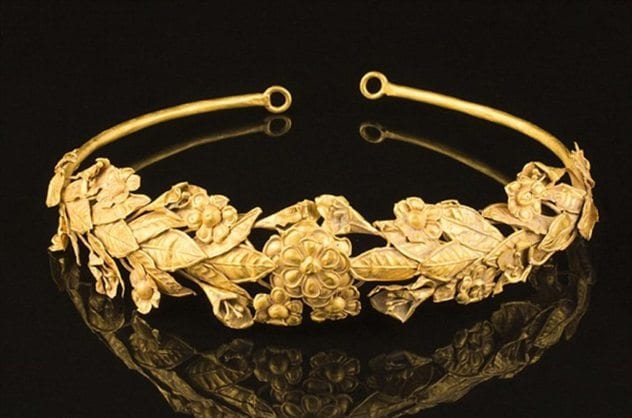
An elderly British man made a shocking discovery under his bed. In a cardboard box inherited from his grandfather, he found a 2,300-year-old Greek crown made of pure gold. Experts determined it to be an authentic myrtle wreath crown and dated it to 300 BC. The crown is 20 centimeters (8 in) across and weighs roughly 100 grams (3.5 oz). Stylistic elements suggest a master goldsmith in Northern Greece forged the piece. Dirt embedded deeply in the crown suggests it was once buried.
Ancient Greeks used wreath crowns for religious festivals and athletic competitions. Myrtle wreaths were specifically associated with Aphrodite. Myrtle was sacred to the goddess, and crowns composed of it were tangible reminders of love’s power. No one knows where the discoverer’s grandfather picked up the crown. He traveled extensively in the 1940s and 1950s and was particularly interested in Alexander the Great’s Macedonian homeland.
3 Old Gold
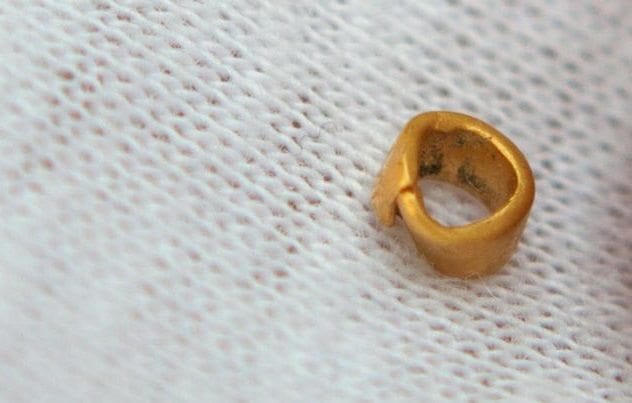
Archaeologists recently unearthed the world’s oldest processed gold in Bulgaria. Dated to 4500 BC, the 3-millimeter gold bead was discovered at Tell Yunatsite. The find is 200 years older than the previously oldest-known gold, which was also discovered in Bulgaria at Varna. Experts believe Tell Yunatsite may be one of the oldest urban sites in Europe. A 2.7-meter (9 ft) wall surrounded the Bronze Age Balkan settlement, suggesting that they had great resources to protect.
Archaeologists believed that the inhabitants of Tell Yunatsite had migrated out of the Anatolia only a few centuries earlier. How they developed advanced metallurgy remains a mystery. Researchers now believe the inhabitants were part of a vast trade network and may have practiced industrial metalworking for the first time in history. Mysterious symbols discovered on a votive tablet from nearby Gradeshnitsa may prove that they also developed one of the earliest-known written scripts.
2 Gold-Hilted Sword
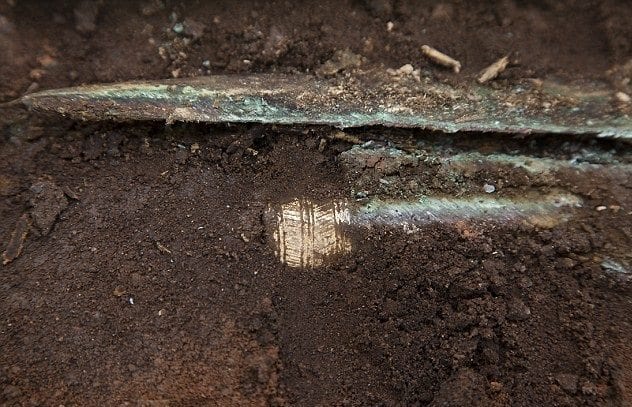
While excavating a new soccer field, Scottish workers unearthed a treasure trove of Bronze Age artifacts. Among these, they discovered a mysterious sword with a golden hilt. Believed to be 4,000 years old, the sword is so delicate that researchers are unable to remove it from the ground. Their goal is to lift the entire block of surrounding soil and transfer it to a lab environment. Given its delicate nature, the find may be either a spear point or a broken sword.
Scotland is filled with Bronze Age sites. Researchers were recently able to recreate the likeness of a Scottish woman, “Ava,” who died 3,700 years ago. It turns out the Bronze Age inhabitants of the Scottish Highlands are physically indistinguishable from their modern counterparts. Work on the soccer field has been halted until archaeologists can investigate the site.
1 Golden Plates Of The Wind Gods
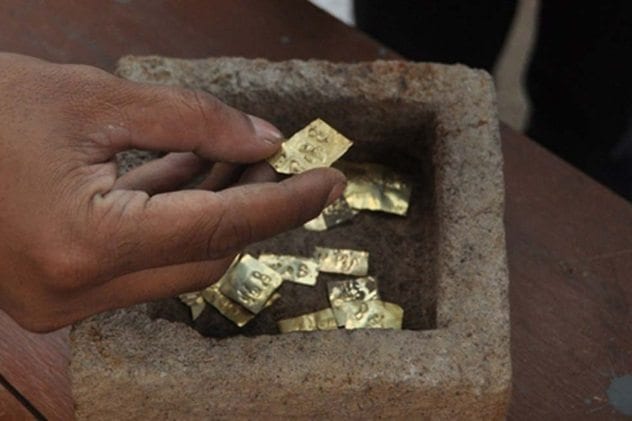
In 2016, workers in Java discovered a box containing 22 small golden plates. Dated to the eighth century AD, the plates contain divine symbols and characters. Workers discovered the remains of a candi, or temple, in the same vicinity.
The plates were found in a rock pile in Ringilarik village. They are 18-karat gold and etched in ancient Javanese script. The inscriptions give the cardinal directions of the wind gods of the ancient Javanese version of Hinduism. So far, experts have recorded the names of eight separate wind gods from the tablets.
Many discoveries were made in the region in 2016. Archaeologists unearthed the remains of another temple and statues dating to Java’s ninth-century Shiva Hindu period. The Central Java Heritage Conservation Agency has declared the location where the gold tablets were discovered a heritage site—a significant achievement in a Muslim-dominated country.
Abraham Rinquist is the executive director of the Winooski, Vermont, branch of the Helen Hartness Flanders Folklore Society. He is the coauthor of Codex Exotica and Song-Catcher: The Adventures of Blackwater Jukebox.
